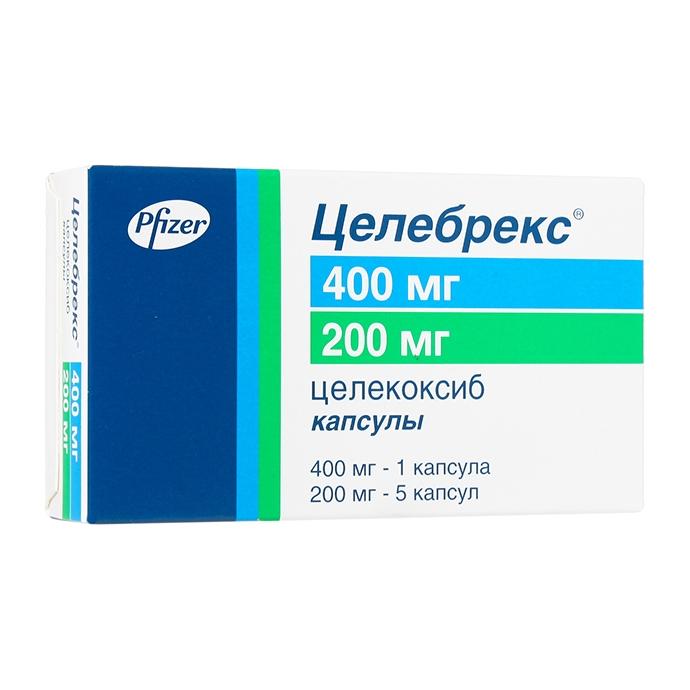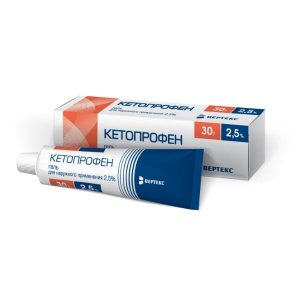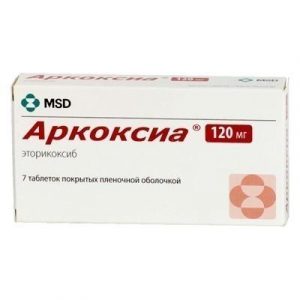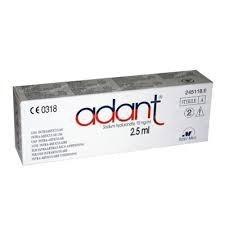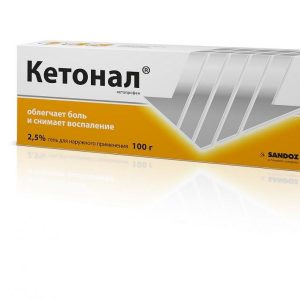Description
Release form
Capsules
Packaging
6 pcs
Pharmacological action
Celecoxib has anti-inflammatory, analgesic and antipyretic effects, blocking the formation of inflammatory prostaglandins (Pg) mainly due to inhibition of cyclooxygenase-2 (COX-2). Induction of COX-2 occurs in response to inflammation and leads to the synthesis and accumulation of prostaglandins, especially prostaglandin E2, while there is an increase in the manifestations of inflammation (edema and pain). In therapeutic doses in humans, celecoxib does not significantly inhibit cyclooxygenase-1 (COX-1) and does not affect prostaglandins synthesized as a result of COX-1 activation, and also does not affect the normal physiological processes associated with COX-1 and occurring in tissues, and especially in the tissues of the stomach, intestines and platelets.
Impact on renal function
Celecoxib reduces urinary excretion of PgE2 and 6-keto-PgF1 (a prostacyclin metabolite), but does not affect serum thromboxane B2 and urinary excretion of 11-dehydro-thromboxane B2, a thromboxane metabolite (both are COX-1 products ) Celecoxib does not cause a decrease in glomerular filtration rate (GFR) in elderly patients and people with chronic renal failure, and transiently reduces sodium excretion. In patients with arthritis, the observed incidence of peripheral edema, arterial hypertension, and heart failure is comparable to that with the use of non-selective COX inhibitors that have inhibitory activity against COX-1 and COX-2. This effect was most pronounced in patients receiving diuretic therapy. Nevertheless, there was no increase in the frequency of cases of increased blood pressure and the development of heart failure, and peripheral edema was mild and passed on its own.
Indications
– osteoarthritis
– rheumatoid arthritis
– pain of various etiologies (including postoperative, toothache, menstrual, bone and muscle pain).
Contraindications
– a history of allergic reactions (urticaria, bronchospasm), associated with the use of acetylsalicylic acid or other NSAIDs
– severe renal dysfunction
– severe liver dysfunction
– III trimester of pregnancy
– lactation (breastfeeding)
– known hypersensitivity to
sulfonamides – increased sensitivity to the component.
Special instructions
Celebrex should be used with caution in case of gastric or duodenal ulcer, ulcerative colitis, heart failure, edema syndrome, arterial hypertension.
Celebrex can be used with low doses of acetylsalicylic acid. Due to the lack of action on platelets, Celebrex does not replace acetylsalicylic acid in the prophylactic treatment of cardiovascular disorders.
With a decrease in CYP2C9 activity, Celebrex should be prescribed with caution, since in this case the plasma level of celecoxib may increase excessively.
Monitoring laboratory parameters
During use of the drug, monitoring of the peripheral blood picture and laboratory parameters of liver and kidney function is necessary.
If it is necessary to determine 17-ketosteroids, the drug must be discontinued 48 hours before the study.
Use in pediatrics
Clinical data on the efficacy and safety of Celebrex in children and adolescents under the age of 18 are not available.
Influence on the ability to drive vehicles and control mechanisms
The question of the possibility of engaging in potentially hazardous activities that require increased attention and speed of psychomotor reactions should be decided only after evaluating the patient’s individual reaction to the drug.
Composition
1 capsule contains:
Active ingredient: celecoxib
Side effects of the
From the digestive system: often – abdominal pain, diarrhea, dyspepsia rarely – nausea, vomiting, heartburn, anorexia with prolonged use in high doses – ulceration of the gastrointestinal mucosa, bleeding, NSAIDs, gastropathy, constipation, flatulence, increased activity of AST and ALT.
From the side of the central nervous system and peripheral nervous system: rarely – headache, dizziness, drowsiness or insomnia, blurred vision, depression, agitation, confusion, anxiety, hallucinations, hearing loss, tinnitus.
From the respiratory system: rarely – sore throat, cough, shortness of breath, bronchospasm.
From the urinary system: rarely – renal failure, edematous syndrome.
From the hemopoietic system: rarely – agranulocytosis, anemia, leukopenia, thrombocytopenia.
From the cardiovascular system: rarely – arterial hypertension, arrhythmia, hot flashes, palpitations, congestive heart failure, tachycardia.
Allergic reactions: bullous skin rash, angioedema, bronchospasm, anaphylaxis, vasculitis, erythema multiforme, Stevens-Johnson syndrome.
Other: alopecia, sweating, nosebleeds. There are separate reports of acute pancreatitis.
Drug interaction
With the simultaneous use of Celebrex with a CYP2C9 inhibitor fluconazole, an increase in plasma concentration of celecoxib is possible (celecoxib should be used at the lowest recommended dose).
It was established in vitro that celecoxib is an inhibitor of CYP2D6, so there is a likelihood of drug interaction with other drugs that are biotransformed with this isoenzyme.
Antacids (aluminum and magnesium) reduce the degree of absorption of celecoxib by 10%, which does not cause clinically significant effects.
When studying the effect of Celebrex on the pharmacokinetics and / or pharmacodynamics of the CYP2C9 substrates of gliburide, glibenclamide, tolbutamide, no clinically significant interaction was found in vivo.
In vitro studies found that the isoenzyme CYP2C19 can take part in the metabolism of celecoxib only to a small extent. In an in vivo study, multiple doses of celecoxib (200 mg 2 times / day for 7 days) did not affect the clearance of a single dose of phenytoin CYP2C19 substrate. It is believed that the risk of clinically significant inhibition by celecoxib of CYP2C19 substrate metabolism is negligible.
With the combined use of Celebrex with warfarin and similar drugs, an increase in prothrombin time and the development of serious bleeding is possible (it is necessary to monitor coagulation parameters and apply precautions).
No clinically significant interaction of celecoxib with ketoconazole, lithium preparations, methotrexate was detected.
Overdose
There is no clinical experience of overdose. Healthy volunteers were given up to 1200 mg once and up to 1200 mg twice daily without clinically significant adverse effects.
Treatment: carry out symptomatic therapy. Hemodialysis is ineffective.
Storage Conditions
The product should be stored in a dry, inaccessible place for children at 15 ° C to 30 ° C.
Shelf life
3 years
Deystvuyushtee substance
Celecoxib
Pharmacy terms
Prescription
dosage form
capsules
Possible product names
Celebrex capsules 400 mg 1 pc. + 200 mg 5 pcs.
